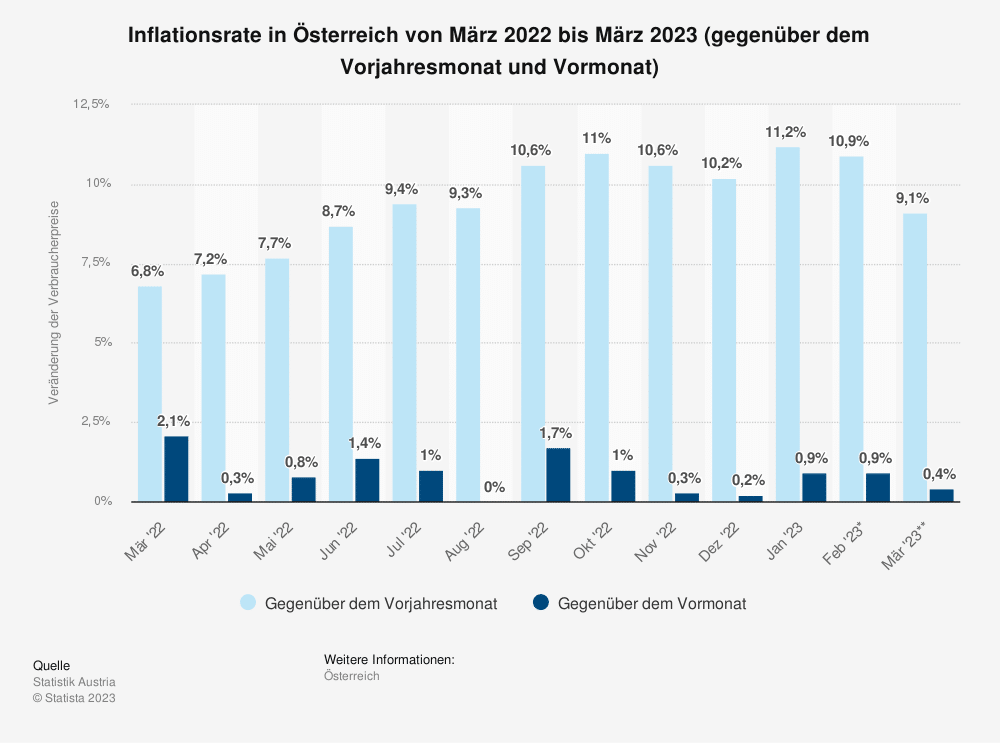Life has become significantly more expensive since the inflation rate more than tripled compared to 2021, and there is still no end in sight to the wave of rising prices. While we can feel the effects directly and immediately at the petrol station, in the supermarket, or in the restaurant, another arena is easily overlooked: millions of savings accounts are gradually losing value due to inflation. What can be done against this creeping loss of wealth? One answer is to invest in real assets, as is possible through the ERSTE REAL ASSETS fund. It offers opportunities for return in trying times like these, but naturally also comes with risks.
At the moment, it seems the only way is up for prices
Statistical data confirm what we can feel on a daily basis in all areas: in 2022, consumer prices increased by 8.6 % compared to the previous year. Most recently, inflation had even increased to double-digit terrain.
Inflation rate in Austria, February 2022 to February 2023 (month-on-month and relative to the referential month of the previous year)

A look at specific price drivers that have recorded particularly marked increases over this period is also revealing:
What prices have increased the most in the past year:
- Flight tickets + 58.2 %
- Energy + 37.0 %
- Pets + 18.2 %
- Home maintenance + 17.9 %
- Food + 16.5 %
- Cars + 14.1 %
- Non-alcoholic beverages + 14.0 %
- Fuels + 13.5 %
- Restaurants + 13.7 %
- Furniture and carpets + 13.7 %
- Accommodation + 13.1 %
- Newspapers/magazines + 12.9 %
Reference period: 02/2022 – 02/2023, Source: Statistic Austria (personal inflation calculator)
https://www.statistik.at/persoenlicher_inflationsrechner/index_en.xhtml
What is the outlook for inflation?
There is no ultimate answer to this burning question, but there are many indications suggesting that inflation will weaken slightly. According to the current inflation forecast of Oesterreichische Nationalbank (OeNB), i.e. the Austrian central bank, the inflation rate in relation to the harmonised consumer price index is expected to decline significantly in the course of the year. That being said, it will still amount to 6.9% for the whole year of 2023. The easing inflationary pressure from energy prices will be coming at a time when domestic price pressure from wage settlements will be on the rise. If OeNB’s forecast is to be trusted, the inflation rate is expected to fall to 4.0 % in 2024 and to 3.2 % in 2025 – which, however, is still higher than the European Central Bank’s target of 2%.
What does all this mean for investments?
In short, those who have money are among the losers due to inflation. In particular, money held in low-interest savings accounts and low-yield investments has been, figuratively speaking, melting away since interest rates fell below the rate of inflation, as was the case in 2015. The capital and the vanishingly small interest income are currently being eaten up by inflation. Even since the last interest rate increases by the European Central Bank, conventional forms of savings have hardly yielded any interest. Those who have their money in a savings book are therefore continuously losing massive amounts of wealth.
This is how negatively increased inflation and zero interest rate policies affect real purchasing power:
| Year | Purchase power | Inflation rate |
| 0 | 100,000 € | 5 % |
| 1 | 95,000 € | 5 % |
| 2 | 90,250 € | 5 % |
| 3 | 85,738 € | 5 % |
| 4 | 81,451 € | 5 % |
| 5 | 77,378 € | 5 % |
| 10 | 59,874 € | 5 % |
Source: own calculations
Therefore, the declared goal for all those with disposable money should be to achieve a return that is permanently above the rate of inflation. Only this scenario ensures the maintenance of the value of capital in the long term. Since this goal does not seem to be achievable with traditional forms of saving for the time being, alternatives are increasingly coming into focus.
Real assets in demand
We can currently see a strong trend towards tangible assets – i.e. assets with material value – among investors who want to invest their money without losses and without taking major risks. Due to their limited nature, they promise a stable development of value that is not influenced by inflation. “Land register instead of savings book” is the motto of this development in a nutshell. Gold, too, will always be an option due to its physical value, especially in times of crisis. However, investing in tangible assets also involves a high degree of organisation, personal involvement, and add-on costs. This includes the difficult question of real estate selection, the search for reliable tenants, and the question of where to store gold safely and protect it from theft.
If you’d rather do without these hurdles, you can also opt for an investment fund that invests in tangible assets – ERSTE REAL ASSETS, for example.
Please note that investing money in investment funds also involves risks.
Investing in assets with continuity
The fact that ERSTE REAL ASSETS is one of the most popular funds among Erste Bank and Sparkassen customers is no coincidence: its composition is geared towards stable value development, which is to be ensured by a mix of approx. 50% global equities, 33% gold[1], and 17% real estate funds or commodities.
[1] Acquisition usually in the form of exchange-traded commodities (debt securities). Physical delivery of the precious metals mentioned is not permitted. The currency risk of the gold component is predominantly hedged in euro.
Real investment in companies
When you invest your capital in shares, you receive real value in return. You become co-owner of a real company that generates real sales and profits.
Companies constantly adjust the prices of their products to the current economic environment. Rising costs for raw materials or wages are passed on to end customers, which cushions inflationary developments. Depending on the economic cycle, shares can therefore contribute to wealth preservation.
Stable return through real estate investments
Given that ERSTE REAL ASSETS also invests in real estate funds, investors hold an indirect interest in a large number of properties. The value of assets depends on the current income and its risk. Real estate is a durable and stable asset. It generates ongoing income through tenants. As a rule, rents are adjusted for inflation. This can help absorb the risk of purchase power losses.
Gold is forever
Unlike the money supply, the amount of gold available is limited and cannot be controlled at will. This ensures a certain safeguarding of purchasing power. History has shown that the demand for gold and thus its value increases especially during economic and political crises. Gold in the portfolio ensures even broader risk diversification and may also work as an additional source of income.
It’s all in the mix
In a nutshell, broad diversification – that is, a wide spread of risk – is the best protection against inflation. Negative outliers in individual asset classes are usually offset by gains in other areas. Even if the bears had the upper hand on the stock market in 2022, real assets such as shares, real estate, and gold generally have significantly more return potential than a conventional savings book.
Information helps to take sound decisions
If you have your money in a savings account and do not want to watch it getting eaten up by inflation, you need to take action. Comprehensive information is crucial. At Erste Bank and Sparkasse you will get competent advice on all of your options.
Interesting to know: since 31 March 2022, ERSTE REAL ASSETS has also been eligible for the s Fund Plan, i.e. the ERSTE fund savings plan. It takes as little as EUR 50 per month to sign up.
For further information on fund savings plans, please visit: Fund saving (erste-am.at)
For more information on ERSTE REAL ASSETS: ERSTE REAL ASSETS Retailtranche: EUR R01 – Factsheet (erste-am.at)

The fund pursues an active investment policy and does not follow a benchmark. The assets are selected at our discretion, without any constraints to the latitude of judgement on the investment company’s part.
Benefits for the investor:
- Investment focus on real assets
- The investment goal is long-term capital growth
- The diversification of the investment across various asset classes may reduce the risk of capital loss
- Investment funds are special assets
Risks to bear in mind:
- The price of the assets the fund is composed of may be subject to significant fluctuations
- Due to investment in foreign currency, the value of the fund may be affected by foreign exchange fluctuations
- Alternative asset classes contain a higher risk potential
- Capital loss is possible
- The following risks may be of particular relevance to the fund: credit risk, counterparty risk, liquidity risk, deposit risk, derivative risk, and operational risks. For comprehensive information on the risks of the fund, please refer to the prospectus and to the information for investors according to sec. 21, part II, chapter “Risk notices” of the Austrian Alternative Investment Fund Managers Act
For a glossary of technical terms, please visit this link: Fund Glossary | Erste Asset Management
Important legal notice:
Forecasts are no reliable indicator of future performance.
Please note that an investment in securities also involves risks in addition to the opportunities described.

